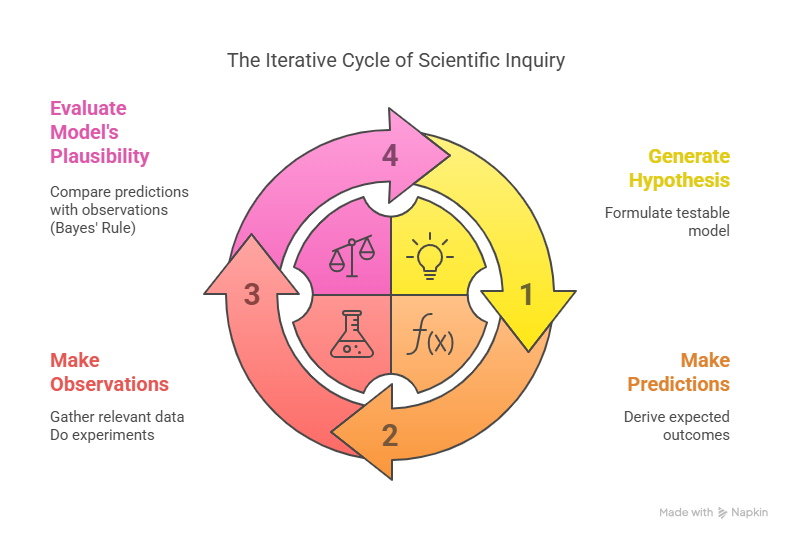
Linear Modelling
Bayesian Methods for Ecological and Environmental Modelling
UKCEH Edinburgh
What we will cover
2-3.30 pm: Session 3 Linear modelling - part 1
- Recap basics & MCMC
- Linear models - terminology, theory & assumptions
- Practical 3a: Use MCMC with simple linear models
3.30-4 pm: Tea & coffee break
4-5 pm: Session 3 Linear modelling – part 2
- Practical 3b: Linear models with informative priors
- Other kinds of systems & models
Recap - Bayesian basics
Science and Models
The core of the scientific process involves:
- formulating models of how the world works
- comparing with data to assess their validity
Inference is the process of estimating models, parameters, and their uncertainties, using data
- how we go from evidence to a conclusion
Terminology
- hypothesis = a statement of how a system works
- e.g. CO\(_2\) causes global warming
- model = mathematical representation of how a system works
- e.g. Temperature = f(CO\(_2\))
- parameter = numerical constant within a model
- e.g. \(T = \alpha + \beta [CO_2]\)
- true value unknown, but estimated with uncertainty
Likelihood and probability
“Likelihood” and “probability” used interchangeably in common speech.
Likelihood has a specific meaning in statistics:
- parameters have a likelihood:
- \(L[\alpha, \beta] = P[\mathrm{data} | \alpha, \beta]\)
- equal to the probability of the data, given those parameters
How science works

Bayesian inference
The mathematically correct way to do inference with conditional probability
- estimate parameters \(\theta\) from data \(y\)
- only really feasible with modern computers
- posterior \(\propto\) prior \(\times\) likelihood
- \(P(\theta | y) \propto P(\theta) P(y | \theta)\)
“Classical”/“frequentist” statistics
- an ad hoc invention of the 1920s
- easy to compute, often gives similar answers, BUT:
- quantifying uncertainty is hard
- restricted to simple models, Gaussian parameters
- encourages misguided mindset
- confuses \(P(\theta | y)\) with \(P(y | \theta)\)
Markov Chain Monte Carlo (MCMC)
- general method for how to implement Bayesian inference
- samples the unknown distribution of \(\theta\)
- using known likelihood function
Next:
- apply MCMC to simple linear models
Linear models
Terminology
- Linear Models
- Linear Regression
- Regression modelling
- the General Linear Model includes:
- t-test
- ANOVA
- multivariate regression
We want to predict one thing (y) on the basis of another (x)
Terminology
- y: response, outcome, dependent variable
- x: predictor, covariate, independent variable
- used to help understand the variability in the response
Linear model
A function that describes a linear relationship between the response, \(y\), and the predictor, \(x\).
\[\begin{aligned} y &= \color{black}{\textbf{Model}} + \text{Error} \\[6pt] &= \color{black}{\mathbf{f(\theta, x)}} + \epsilon \\[6pt] &= \mathrm{intercept} + \mathrm{slope} \cdot x + \epsilon \\[6pt] &= \alpha + \beta x + \epsilon \\[6pt] \theta &= (\alpha, \beta) \\[6pt] \end{aligned}\]
Linear model
A function that describes a linear relationship between the response, \(y\), and the predictor, \(x\).
\[\begin{aligned} y &= \color{black}{\textbf{Model}} + \text{Error} \\[6pt] &= \color{black}{\mathbf{f(\theta, x)}} + \epsilon \\[6pt] &= \mathrm{intercept} + \mathrm{slope} \cdot x + \epsilon \\[6pt] &= \beta_0 + \beta_1 x + \epsilon \\[6pt] \theta &= (\beta_0, \beta_1) \\[6pt] \end{aligned}\]
Linear model
\[ \begin{aligned} y &= \color{purple}{\textbf{Model}} + \text{Error} \\[8pt] &= \color{purple}{\mathbf{f(\theta, x)}} + \epsilon \\[8pt] &= \color{purple}{\alpha + \beta x} + \epsilon \\[8pt] \end{aligned} \]

Linear model + residual error
\[\begin{aligned} y &= \color{purple}{\textbf{Model}} + \color{blue}{\textbf{Error}} \\[8pt] &= \color{purple}{\mathbf{f(\theta, x)}} + \color{blue}{\boldsymbol{\epsilon}} \\[8pt] &= \color{purple}{\alpha + \beta x} + \color{blue}{\boldsymbol{\epsilon}} \\[8pt] \end{aligned}\]

Linear model + residual error
\[\begin{aligned} y &= \color{purple}{\textbf{Model}} + \color{blue}{\textbf{Error}} \\[8pt] &= \color{purple}{\mathbf{f(\theta, x)}} + \color{blue}{\boldsymbol{\epsilon}} \\[8pt] &= \color{purple}{\alpha + \beta x} + \color{blue}{\boldsymbol{\epsilon}} \\[8pt] \end{aligned}\]

Uses
- Prediction
- Extrapolation
- Associations / correlation
- Causal inference
Terminology
Regression slopes \(\beta\) are often referred to as effects
- e.g. \(\beta = 1.5\) is the numerical effect of \(x\) on \(y\) in the model
- but effect implies causality
- better called coefficient to be neutral
Frequentist linear regression
- find the best-fit line which minimises residuals
- point estimate for the relationship between x and y
- assume Gaussian approximation for confidence intervals
- test null hypothesis of zero slope \(\beta = 0\)

Bayesian linear regression
- find the (posterior) distribution of plausible relationships between x and y
- i.e. \(P(\theta | y) \propto P(\theta) P(y | \theta)\)
- use Bayes rule via MCMC
- no Gaussian assumption needed for parameters (only measurement error)
- hypothesis test is irrelevant - posterior \(\theta\) captures all information
Assumptions
- Constant variance across the range in \(x\)
- 0 zero error in \(x\)
- Linearity
- Independent samples
- Normally-distributed measurement error
- mnemonic: C0LIN
Extensions to Linear Modelling
When assumptions are not met …
- Independent samples - hierarchical & mixed-effect models; spatial/time series
- Linearity - Generalised Linear Models; General Additive Models
- Normally-distributed measurement error - Generalised Linear Models
Theory into practice …
Two practicals
- Bayesian estimation of the parameters of linear models
- use package in R for MCMC
rstanarm- easy syntax for specifying model
Consider:
- convergence checks
- model predictions
- prior distributions
Tree allometry
- How does tree mass scale with stem diameter?
- Can we reliably estimate forest carbon stocks from simple measurements?

Tree allometry
- How does tree mass scale with stem diameter?
- Can we reliably estimate forest carbon stocks from simple measurements?
Space Shuttle Challenger
- How do we assess risks from uncertain linear relationships?
- How do we combine data with prior knowledge?

